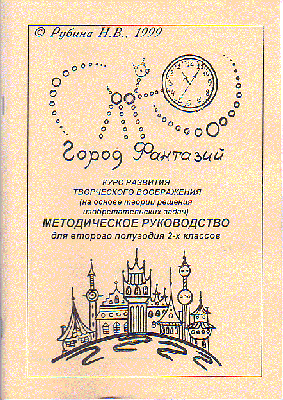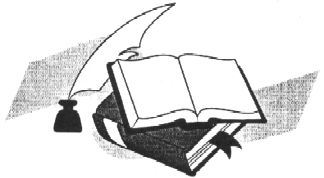Course of Creative Imagination Development (CID) Based on TRIZ, 2nd Grade, 2nd Semester,
Methodical Guide-Book
List of posting in this Home Page:
| Sept. 11, 2001 | 2nd Grade/2nd Semester "Fantasy City" | Preface, Intro., Topics 1-6 (Finished) | Guide-Book | Workbook |
Editor's Note:
Please refer to the Editor's Preface (by T. Nakagawa) and the Author's
Introduction (by N. V. Rubina) on the top page of this Course textbook
series.
| Top of this page | Contents | Front Cover | Preface | Symbol marks | Weekly Topic Planning | CID Course Top Page |
Contents
of the CID Course, 2nd Grade, 2nd Semester Course
Top Page:
| Book Title;
Grade/Semester |
Contents | Guide-
Book |
Work-
book |
Posted
date |
| "Fnatasy
City"
2nd Grade,
|
Preface and Weekly Topic Planning | Sept. 11,
2001 |
||
| Introductory Lesson | Sept. 11,
2001 |
|||
| Methods of Solving Problems
1. "We Wouldn't Be Happy If Misery DidN'T Help Us" (Contradictions) |
Sept. 11,
2001 |
|||
| 2. Both Cold
and Hot
(Physical Contradictions) |
Sept. 11,
2001 |
|||
| 3. "... Sledge, Go Home ByYourself!"
(Ideality) |
Sept. 11,
2001 |
|||
| 4. "Use What Is at Hand, and Don'T
Look for Anything Else"
(Resources) |
Sept. 11,
2001 |
|||
| 5. Problem Solving
6. Project "Ideal City" |
Sept. 11,
2001 |
|||
| Reference
Supplements |
Sept. 11,
2001 |
(C) N.V.Rubina,
I. Dolina, T. Nakagawa, 2001
Fantasy City
Course
of Creative Imagination Development (CID)
(Based on Theory of Inventive Problem Solving
(TRIZ))
METHODICAL GUIDE-BOOK
Second Grade, Second Semester
Natalia V. Rubina
 |
 |

Fantasy City
Course
of Creative Imagination Development (CID)
(Based on Theory of Inventive Problem Solving
(TRIZ))
METHODICAL GUIDE-BOOK
Second Grade, 2nd Semester

Natalia V. Rubina
Petrozavodsk 1999
English Translation by Irina Dolina, May 4, 2001
Technical Editing by Toru Nakagawa, September 3, 2001
The program of the CID course was elaborated and defined in Petrozavodsk in 1996. Six workbooks with special methodological recommendations (for each semester) were worked out. The program and all the methodological material were probated on the basis of the "TRIZ Laboratory" at the Petrozavodsk School #17.
This pamphlet introduces
the methodological instructions for the second semester of the CID second
grade ("Fantasy City").
"Fantasy City". Creative Imagination Development Course for the elementary school (The second semester of the second grade). Methodological instructions.
Reprints and distribution only by author's permission.
 |
(Instead of Preface) |
The Course of Creative Imagination
Development, based on the Theory of Inventive Problem Solving, has rather
concrete aims and purposes. The developed, easily controlled imagination
is important for solving creative problems in the various fields of human
activities. That is why most of the activities are aimed at teaching
the children to think in an organized, systematic way, to use concrete
rules while solving the creative problems. This is not an easy task
for elementary school students. The highest estimation of my work
has become the words of one of the third grade students: ”I like your class,
it makes me THINK!”.
G.S.Altshuller’s theory, which comprises CID
and TRIZ as its part, is an amazingly creative and life-assertive force.
Each CID lesson gives the children and the teacher the happiness of searching
difficult solutions, overcoming personal mental inertia, small victories
over routine.
In the second semester we begin our work on
the basis of the main topic of the course “Method of Solving Creative Problems”.
It is important to emphasis in the beginning that the CID course for elementary
school doesn’t put forward the task to teach all the children to master
perfectly all the rules and methods of TRIZ. Our task is to lay the
foundation for further deep studies of the theory, to cultivate interest
for solving creative and research problems. The children have very
different abilities: some of them can understand and use rather complicated
mechanisms of solving problems (such as contradictions, system approach,
ideal solutions, etc), others instead of taking well-thought and precise
steps to solve problems, sort out for a long time unsuccessful variants.
Sometimes it seems that the children with their “uncontrolled fantasy”
find interesting solutions “purely by intuition”. In order to make
sure that our students’ thinking is becoming more organized, systematic,
compare the previous works (for example, the stories of the first semester)
with the ones that start to appear later.
“Fantasy City” (the CID course for the second
grade) is the continuation of “Fairy Tales School” (the CID course for
the first grade). The adventures of the familiar characters Colabo,
Emil, Magician Deli-Davai, continue there, the work aimed at building systematic
thinking, developing imagination, memory, attention, emotions continues
as well. The lessons are prepared in accordance with the same pattern,
as in the other parts of the course.
The work on studying the method of problem
solving continues in the course for the third grade: ”Planet of Unsolved
Problems”.
In this book the ideas of many TRIZ professionals
are applied. For convenience, quotations from the original works
are cited. It will save your time, and help to understand better
the CID methods and devices.
The author expresses her deep gratitude to
I. N. Murashkowska, A. A. Nesterenko, M. S. Gafitulin, M. S. Rubin, I.
L. Vickentyev, N. N. Khomenko, V. I. Timohov, S. V. Sychov and to other
TRIZ-CID professionals, whose works have contributed in preparing this
CID Course. And, of course, the contribution of the 1-3 grade students
of School #17 of Petrozavodsk is invaluable. Thank you, my little
magicians!
The world of amazing, difficult and interesting
creative problems is waiting for us.
Send your comments, suggestions and
applications for CID course workbooks and methodical guide books to the
following address:
185014, Petrozavodsk, mail box 8, “TRIZ- Karelia”.
For better
perception the following symbols are used in the methodical guide-book:
 |
- problems. For the first grade simple problems demanding answers "yes-no" are used. The major notions of the methods of solving problems are studied in the second and third grades. That is why the most suitable form for solving creative problems is a game "yes-no". The rules of the game are not difficult. After the problem is introduced the kids start to look for the solution by asking questions to which the teacher replies "yes" or "no". The aim of the game is to find a solution by asking as many questions as possible. |
 |
- activities. During these activities it is important that the kids understand how this or that notion may be used for solving the problems, for obtaining new ideas, etc. |
 |
- psychotechnical games. This is a specific part of the lesson. Kids may relax a little and turn to their inner world, the world of a child's fantasy. It goes without saying how important is the atmosphere of trust, friendliness in your small community. |
 |
- speech developing activities. We all know very well how easy to speak with a person who can ask interesting questions. CID classes are structured in a form of a dialogue, therefore actually any task is an exercise on speech developing. Nevertheless, devising their own riddles, proverbs, tales, the kid learns not only to say "full sentences", but develops a need to formulate his idea in such a way that he would be understood and his wits and humor be assessed. Describing various systems, solving unusual problems, the kids enrich their vocabulary all the time. |
 |
- designing a creative product. Don't be confused by an unusual term. "Creative product" is something finished, designed by the kids with the help of methods they study (a riddle, a proverb, a tale, a model of a toy, articles of natural materials and others). |
 |
- tasks-pictures. At the CID classes there are many activities like that because a new creative idea is often embodied in images, especially it refers to the kids with a strong visual representative system. Most of these tasks are unique stuff for a psychologist, for attentive parents, because in this pictures the inner world of a child is reflected as if in a mirror. |
Weekly Topic Planning
(2nd Grade, 2nd Semester)
| Date | Topic | No. of hours | |
| January | 1st week | Introductory Lesson | 1 hour |
| 2nd week
3rd week |
Method of solving problems
Topic 1. "We Wouldn't Be Happy If Misery Didn't Help Us ..." (Contradictions) |
2 hours | |
| February | 1st week
2nd week |
Topic 2. Both Cold and Hot (Physical contradiction) | 2 hours |
| 3rd week
4th week |
Topic 3. "... Sledge, Go Home By Yourself!" (Ideality) | 2 hours | |
| March | 1st week
2nd week |
Topic 4. "Use What Is at Hand, and Don't Look for Anything Else" (Resources) | 2 hours |
|
April |
3rd week
1st week |
Topic 5. Solving Problems | 2 hours |
| 2nd week
3rd week |
Topic 6. Ideal City (Solving problems from different fields of knowledge) | 2 hours | |
| May | 1st week | Reviewing material, studied in the second grade | 1 hour |
| 2nd week
3rd week |
DKR.
What to check:
|
2 hours |
|
[Translation Note (T.Nakagawa,
Sept. 3, 2001): This table of Weekly Topic Planning was modified
slightly to better match with the body of the text.]
| Top of this page | Contents | Front Cover | Preface | Symbol marks | Weekly Topic Planning | CID Course Top Page |
| Home Page | New Information | Introduction to TRIZ | TRIZ References | TRIZ Links |
| TRIZ News & Activities | TRIZ Software Tools | TRIZ Papers and Tech Reports | TRIZ Forum |
Last updated on Sept. 11, 2001. Access point: Editor: nakagawa@utc.osaka-gu.ac.jp